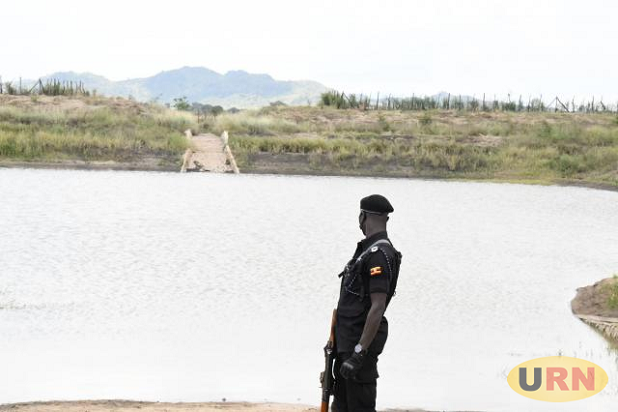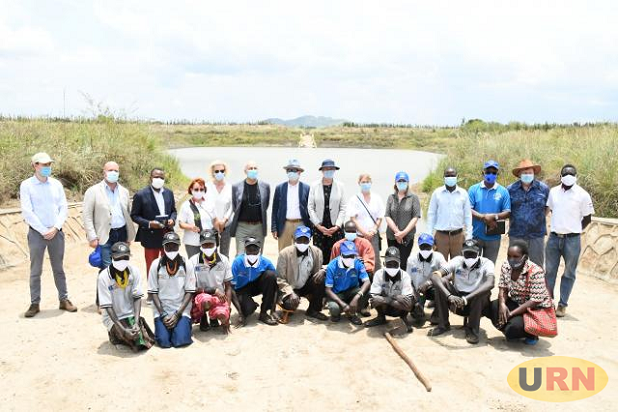European Union Ambassadors together with some community members pose in-front of a dam in Kakamar sub-county, Kaabong district.
A multi-million valley dam in Kakamar sub-county in Kaabong district funded by the European Union (EU) is lying idle due to cattle thefts that have left the entire sub-county without a single cow.
The valley dam is part of a bigger project comprising 8 valley dams built in different areas in Karamoja sub-region at Shillings 46 billion (11 million Euros). During their onsite visit on Tuesday, nine ambassadors under the European Union (EU) learnt that the dam is currently used mainly by elephants after more than 8,000 cattle for which it was built were raided.
The last raid occurred on June 19th, 2021, according to Joseph Tikol, the Kakamar Sub-county LC III Chairperson. He explained that there have been three major raids since the dam was constructed.
“I remember one raid on 28th February 2019 where about 3,500 head of cattle were lost. And then this recent one, we lost about 4,500 cattle. The government recovered about 60 but again, not even a week elapsed…the raiders came back for them,” Tikol recounted.
He asked the government together with the EU to refocus their support in the area towards irrigation so that it supports farming due to loss of cattle by communities.
Tikol says elephants from Kidepo National Park have taken advantage of the idle dam.
Mathias Schauer, the German Ambassador revealed that the 11 million Euros project for the dams was jointly funded by GIZ, the European Union-EU, the British DFID and other development partners.
He says that the project dubbed ‘Water for Production’ was envisaged to support livelihoods in the area considering that during the dry season when other reservoirs have dried up, there is an urgent need to supply cattle with water and also avoid conflicts.
Schauer said they would engage the community more and deliberate on other proposals regarding the valley dam amidst cattle raids.

Eng. Daniel Baguma, the project works superintendent from the Ministry of Water and Environment said that the facility was constructed to sustain a minimum of 3,000 cows for at least 3 months.
He also revealed that they are currently making studies for small scale irrigation systems in Karamoja sub-region.
The EU Heads of Mission currently in Karamoja sub-region include the head of Delegation, Ambassador Attilio Pacifici, Rudi Veestraeten, the Ambassador of Belgium, Mathias Schauer, the Germany Ambassador, Massimiliano Mazzanti, the Ambassador of Italy, Karin Boven, the Ambassador of Netherlands, Jules- Armand Aniambossou, the Ambassador of France, Maria Hakansson, the Ambassador of Sweden and Nicole McHugh, the Charge d’Affairs of Ireland.
While commencing their visit to the sub-region on Monday this week, Ambassador Pacifici emphasized said the issue of insecurity occasioned by incidents of cattle raids is key on their agenda if the government and different development partners are to address the challenges in the area like tourism and education among others.
For many years, Karamoja was unstable due to cattle rustling that also runs across the border into Kenya and South Sudan. Due to a proliferation of small arms in the area during the 1960s and 1970s, cattle rustling went ruthless with increased numbers of deaths and injuries.
The Uganda People’s Defence Forces (UPDF) then, began a campaign of disarmament or pacification in 2001 leading to more loss of life and livestock. By 2009, armed livestock raids had greatly reduced and today Karamoja is relatively peaceful and stable, apart from some sporadic cattle-raids especially from the Turkana cattle community in Kenya.
-URN





